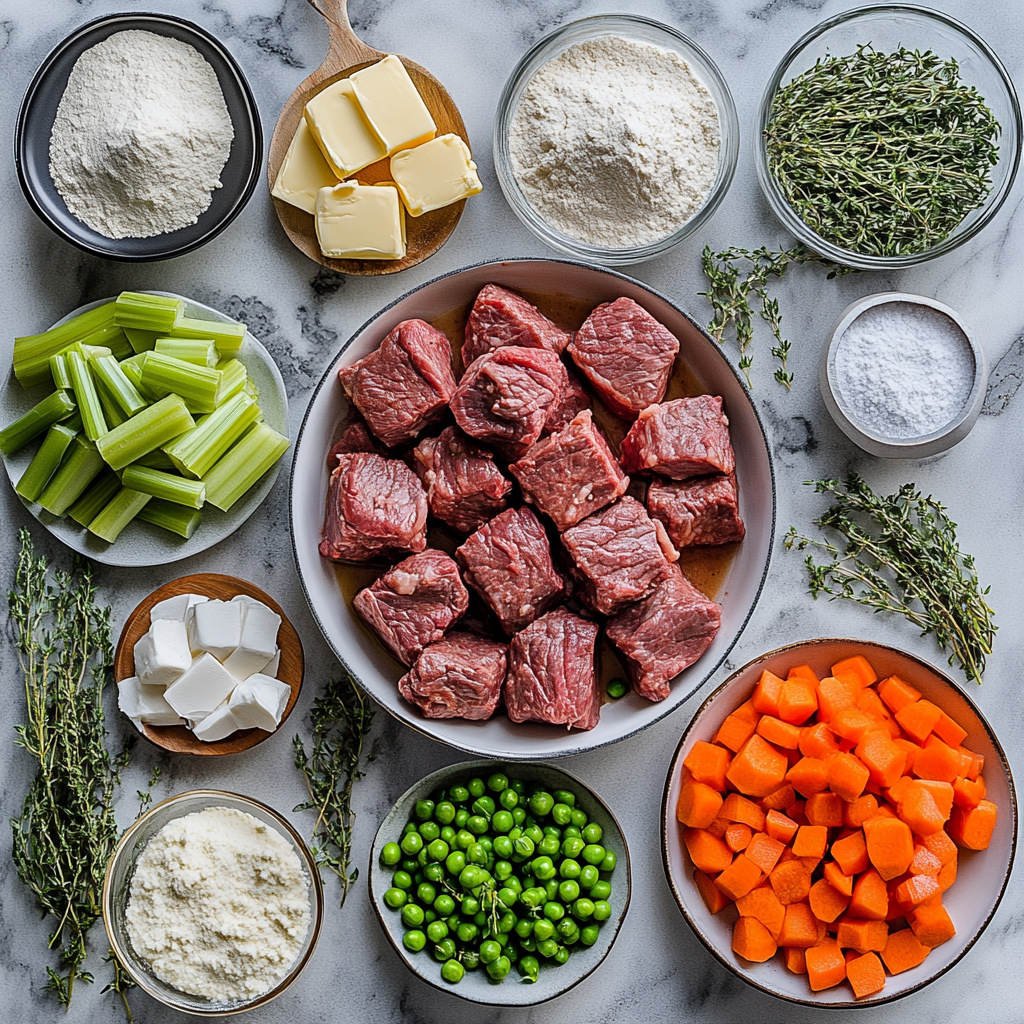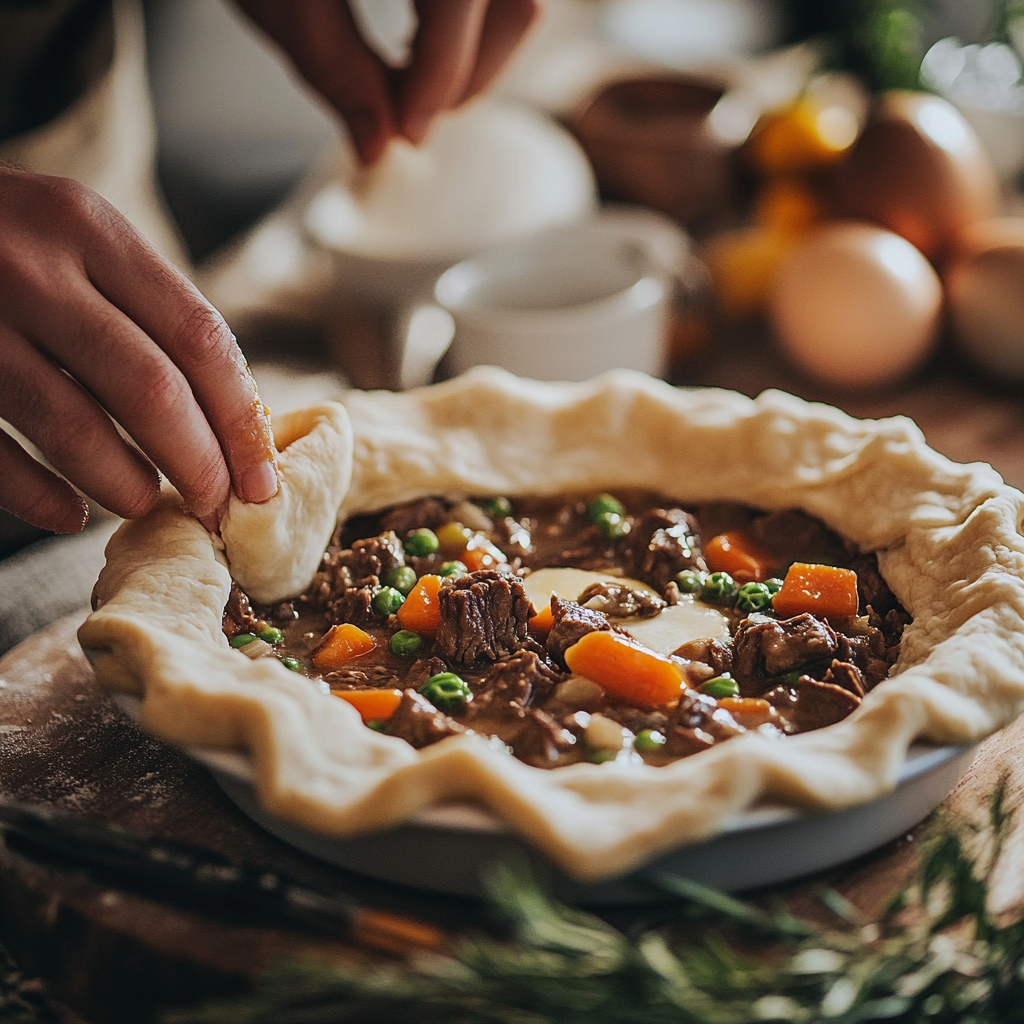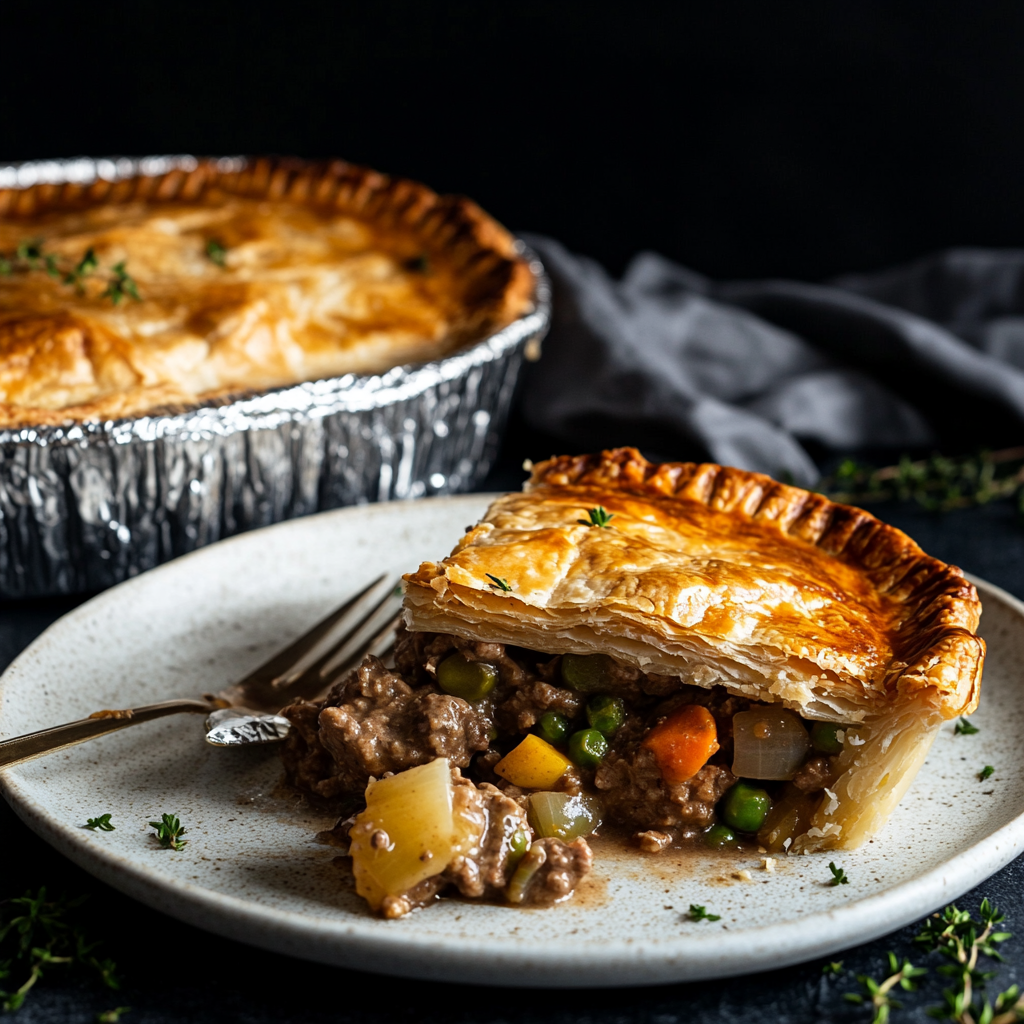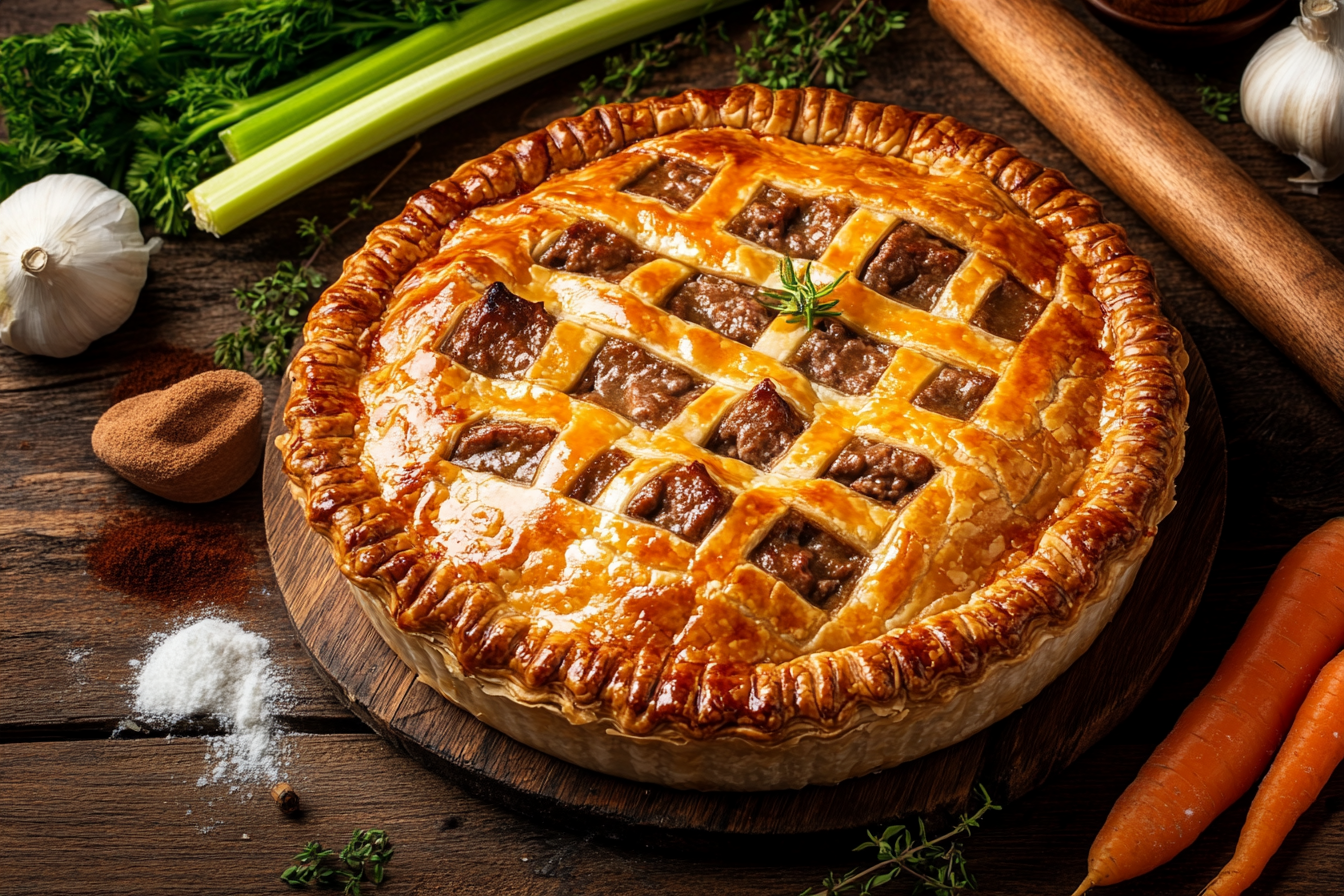Introduction
This beef pot pie recipe is more than just a meal; it’s a symbol of comfort, warmth, and togetherness. With its tender chunks of beef, hearty vegetables, and rich, savory gravy, all enveloped in a flaky, golden crust, it’s a dish that has stood the test of time. Whether you’re a seasoned cook or a beginner, this beef pot pie recipe is sure to become a staple in your kitchen. In this comprehensive guide, we’ll take you through every step of making the perfect beef pot pie, from choosing the best ingredients to mastering the art of the pie crust. Along the way, we’ll explore the history of pot pies, offer variations to suit different tastes, and provide tips to ensure your dish turns out perfectly every time.
A Comfort Food Classic
The origins of pot pies can be traced back to ancient Rome, where they were considered a delicacy among the wealthy. These early versions often included elaborate fillings, such as live birds that would fly out when the pie was cut open. Fortunately, today’s pot pies are more practical and far less surprising. The concept of a pie filled with meat and vegetables was a way to create a hearty, satisfying meal, particularly in colder climates where rich, warm dishes were needed to sustain energy.
In England, pot pies became popular in the 16th century, particularly among the working class, as they provided a way to stretch leftover meats and vegetables into a filling meal. The traditional English pot pie often featured meats like beef, mutton, or pork, combined with root vegetables and encased in a simple pastry crust. The tradition carried over to America, where the beef pot pie recipe evolved into a beloved comfort food, especially in regions with harsh winters.
For those interested in exploring more comforting dishes, you might also want to check out our Hearty Beef and Leek Soup Recipe or the Classic Shepherd’s Pie Recipe, both of which are perfect for cold weather meals.
The Evolution of the Beef Pot Pie Recipe
In the United States, the pot pie became a staple dish during the colonial era. Settlers adapted the traditional English recipes to include local ingredients, such as venison or wild game, and incorporated Native American influences. Over time, the beef pot pie emerged as a favorite, thanks to the availability of beef and the rich, satisfying flavor it provides. The dish became particularly popular in the Midwest and Northeast, where harsh winters demanded hearty, warming meals.
The beef pot pie recipe has since evolved into a versatile dish that can be customized to suit various tastes and dietary preferences. While the traditional recipe calls for a flaky pastry crust and a filling of beef, carrots, celery, and peas, there are countless variations. Some versions include mushrooms, potatoes, or even sweet potatoes, while others swap the pastry crust for a topping of mashed potatoes or cornbread. The possibilities are endless, making the beef pot pie a dish that can be adapted to suit any occasion.
The Key Ingredients for the Perfect Beef Pot Pie Recipe

The quality of your ingredients plays a crucial role in the success of your beef pot pie recipe. Here’s a detailed look at each component and how to select the best options for your dish.
Selecting the Beef
The beef is the star of the show, so it’s important to choose the right cut. The best beef for pot pie is chuck roast or stew beef. These cuts have the right balance of fat and collagen, which break down during slow cooking to produce tender, flavorful meat. When buying beef, look for well-marbled cuts with a bright red color. Avoid any cuts with brown spots or excessive gristle, as these can result in a tough or chewy texture.
For an even richer flavor, you can use short ribs or oxtail, both of which add depth to the gravy. However, these cuts require longer cooking times, so be sure to plan accordingly. If you’re short on time, you can also use leftover roast beef or brisket, which can be shredded and added to the filling without the need for additional cooking.
Vegetables That Make It Hearty
Carrots and celery are classic vegetables that add sweetness and texture to your beef pot pie recipe. These vegetables provide a pleasant contrast to the richness of the beef and gravy, creating a well-balanced dish. Fresh, organic produce is ideal for the best flavor, but frozen vegetables can also be used in a pinch.
Frozen peas work well in pot pie, as they retain their sweetness and color during cooking. Be sure to add them at the end to avoid overcooking, as overcooked peas can become mushy and lose their vibrant green color. If you’re feeling adventurous, consider adding mushrooms, potatoes, or parsnips for variety. Mushrooms add an earthy depth of flavor, while potatoes and parsnips contribute additional heartiness to the dish.
You can also experiment with other vegetables, such as butternut squash, leeks, or turnips. These ingredients can add unique flavors and textures to your pot pie, allowing you to customize the dish to your liking. For more vegetable-focused recipes, you might find our Vegetable Pot Pie Recipe a delightful alternative.
Crafting the Perfect Gravy for Your Beef Pot Pie Recipe
The gravy is the backbone of your beef pot pie recipe, tying all the ingredients together in a rich, savory sauce. Beef broth is the foundation of the gravy in this dish. Choose a high-quality, low-sodium broth to control the saltiness of the dish. You can also use homemade beef stock for an even richer flavor.
Flour is traditionally used to thicken the gravy, but you can also use cornstarch or arrowroot powder for a gluten-free option. When making the gravy, it’s important to cook the flour (or cornstarch) thoroughly to eliminate any raw taste. This step ensures that your gravy has a smooth, velvety texture.
Worcestershire sauce, thyme, rosemary, salt, and pepper are essential for a well-rounded flavor. These seasonings enhance the natural flavors of the beef and vegetables, creating a complex and satisfying dish. For added depth, consider a splash of red wine or balsamic vinegar. These ingredients add a hint of acidity that balances the richness of the gravy, making each bite more enjoyable.
If you prefer a creamier gravy, you can add a splash of heavy cream or half-and-half just before serving. This addition creates a luxurious sauce that pairs beautifully with the flaky crust and tender beef.
Making the Pie Crust
The crust is what sets a pot pie apart from other stews or casseroles, providing a buttery, flaky layer that encases the filling. All-purpose flour is standard for the crust, but pastry flour can be used for a more delicate texture. Pastry flour has a lower protein content than all-purpose flour, resulting in a tender, flaky crust that melts in your mouth.
Unsalted butter is preferred to control the salt content, and it should be very cold to ensure a flaky texture. Cold butter creates steam pockets as it melts during baking, which results in the light, flaky layers that are characteristic of a great pie crust. Some bakers also like to use a combination of butter and shortening, as shortening helps create a more tender crust.
Ice water is crucial for keeping the dough cold and preventing the butter from melting during mixing. When adding water to the dough, do so gradually, one tablespoon at a time, until the dough comes together. Be careful not to overmix the dough, as this can develop the gluten and result in a tough crust.
After mixing, divide the dough into two disks, wrap each in plastic wrap, and refrigerate for at least 30 minutes. This rest period allows the gluten to relax, making the dough easier to roll out. For an extra flaky crust, some bakers like to chill the rolled-out dough in the freezer for 10-15 minutes before baking.
For more tips on making the perfect pie crust, you can visit our Guide to Flaky Pie Crust.
Cooking Steps for Your Beef Pot Pie Recipe

Now that you have your ingredients prepared, it’s time to start cooking your beef pot pie recipe. The following steps will guide you through the process, ensuring that your dish turns out perfectly every time.
Browning the Beef
Start by heating olive oil in a large pot or Dutch oven over medium heat. Add the beef chunks in batches, making sure not to overcrowd the pan. Browning the beef on all sides is a crucial step, as it caramelizes the surface, enhancing the flavor of the final dish. This process, known as the Maillard reaction, creates rich, complex flavors that are essential to the dish.
As the beef browns, it will release fond (the browned bits that stick to the bottom of the pan). This fond is full of flavor and will be incorporated into the gravy later. Once the beef is browned, remove it from the pot and set it aside. If necessary, add a little more oil to the pot before moving on to the next step.
Sautéing the Vegetables for Your Homemade Beef Pot Pie
In the same pot, add the diced onion, carrots, and celery. Sauté until the onions become translucent, about 5 minutes. Add the minced garlic and cook for an additional 1-2 minutes. Sautéing the vegetables in the same pot as the beef allows them to absorb the flavorful drippings, adding depth to the dish.
If you’re using mushrooms, add them at this stage as well. Mushrooms release moisture as they cook, so it’s important to sauté them until most of the liquid has evaporated. This step concentrates their flavor and prevents the filling from becoming watery.
Thickening the Gravy
Next, sprinkle the flour over the sautéed vegetables and stir well to coat. Cook the flour for about 2 minutes to eliminate any raw taste. This step ensures that your gravy will have a smooth, velvety texture. Gradually pour in the beef broth while stirring constantly to avoid lumps. The mixture will start to thicken, creating a rich gravy.
Once the broth has been added, scrape the bottom of the pot to release any browned bits (fond) that may have stuck during browning. These bits are packed with flavor and will enrich the gravy. Stir in the Worcestershire sauce, thyme, rosemary, salt, and pepper, adjusting the seasoning to taste.
Simmering the Filling
Return the browned beef to the pot, along with any accumulated juices. Bring the mixture to a simmer, then reduce the heat to low. Cover the pot and let it cook for about 45 minutes, or until the beef is tender. This slow simmering process allows the flavors to meld together and the beef to become meltingly tender.
If you’re using potatoes or other root vegetables, add them about halfway through the cooking time. These vegetables require longer cooking times than peas, so it’s important to add them early enough to ensure they’re fully cooked by the time the pie is assembled.
Stir in the frozen peas during the last 10 minutes of cooking. This ensures the peas stay vibrant and retain their texture. If you’re adding cream to the gravy, do so at this stage, just before assembling the pie.
Assembling and Baking Your Beef Pot Pie
Now that your filling is ready, it’s time to assemble and bake your beef pot pie recipe. This step brings everything together, creating a dish that’s both visually appealing and delicious.
Preparing the Dough
In a large mixing bowl, combine the flour and salt. Add the cold butter cubes and use a pastry cutter or your fingers to blend the butter into the flour. The mixture should resemble coarse crumbs with some larger pea-sized pieces of butter. Gradually add the ice water, one tablespoon at a time, while mixing the dough with a fork. The dough should start to come together but not be too wet.
Once it begins to hold together, stop adding water. Divide the dough into two disks, wrap each in plastic wrap, and refrigerate for at least 30 minutes. This rest period allows the gluten to relax, making the dough easier to roll out.
For an extra flaky crust, consider rolling out the dough between two sheets of parchment paper. This technique makes it easier to transfer the dough to the pie dish and reduces the need for additional flour, which can toughen the dough.
Assembling the Pot Pie
Preheat your oven to 375°F (190°C). Position a rack in the middle of the oven. On a lightly floured surface, roll out one disk of dough to fit the bottom of your pie dish. Gently transfer the dough to the dish, pressing it into the bottom and sides. Trim any excess dough hanging over the edges.
Spoon the beef filling into the prepared pie crust, spreading it out evenly. Roll out the second disk of dough and place it over the filling. Trim the edges and crimp them with a fork or your fingers to seal the pie. Cut a few slits in the top crust to allow steam to escape during baking.
For a beautiful golden crust, brush the top of the pie with an egg wash (a mixture of beaten egg and water or milk). This step gives the crust a shiny, golden-brown finish that’s as visually appealing as it is delicious.
Baking the Pie
Place the assembled pot pie on a baking sheet to catch any drips. Bake in the preheated oven for 45-50 minutes, or until the crust is golden brown and the filling is bubbling. If the edges of the crust start to brown too quickly, cover them with strips of aluminum foil to prevent burning.
Once baked, remove the pot pie from the oven and let it cool for about 10 minutes before slicing. This resting time allows the filling to set, making it easier to serve. The crust will retain its flakiness, while the filling will be rich and satisfying.
Tips for a Perfect Beef Pot Pie Recipe
Creating a perfect beef pot pie recipe requires attention to detail. Here are some tips to help you achieve the best results every time.
Cold Ingredients are Key
The key to a flaky crust is keeping the butter and water as cold as possible. Consider chilling your mixing bowl and flour before starting. Cold ingredients prevent the butter from melting too quickly, creating steam pockets that make the crust flaky and light.
Don’t Overwork the Dough
Handle the dough as little as possible to prevent it from becoming tough. Overworking develops the gluten in the flour, which can lead to a dense crust. Mix just until the ingredients come together, and then let the dough rest.
Let the Pie Rest
After baking, allow the pie to rest for 10-15 minutes. This resting period helps the filling to set, making it easier to slice and serve. It also ensures that the pie doesn’t spill over when cut, maintaining a clean, attractive presentation.
Experiment with Seasonings
While the traditional seasonings of thyme, rosemary, salt, and pepper are classic, don’t be afraid to experiment with other herbs and spices. A pinch of nutmeg can add warmth, while a dash of cayenne pepper can give the pie a subtle kick. Fresh herbs like parsley, tarragon, or sage can also add brightness and complexity to the dish.
For more seasoning ideas, you might enjoy reading our article on Herbs and Spices for Savory Dishes.
Variations and Serving Suggestions for Your Beef Pot Pie
One of the great things about a beef pot pie recipe is its versatility. Here are some variations and serving suggestions to inspire your next creation.
Try Different Meats
While beef is the traditional choice, you can easily swap it out for other meats. Chicken or turkey pot pie is a popular alternative, especially around the holidays. Lamb is another excellent choice, particularly when paired with rosemary and mint. For a more exotic twist, try using venison or bison, which offer a rich, gamey flavor.
If you’re looking for a vegetarian option, simply omit the meat and add extra vegetables. Root vegetables like sweet potatoes, turnips, and parsnips work well, as do hearty greens like kale or spinach. You can also add beans or lentils for extra protein.
Experiment with Crusts
While a traditional pastry crust is always a winner, there are plenty of other options to explore. A puff pastry crust creates a light, airy topping that contrasts beautifully with the rich filling. For a gluten-free option, try using a crust made from almond flour or a blend of gluten-free flours.
You can also top your pot pie with mashed potatoes for a twist on shepherd’s pie. This variation is especially comforting and pairs well with a rich beef gravy. Cornbread is another great option, adding a slightly sweet, crumbly topping that’s perfect for soaking up the savory filling.
Side Dishes to Pair With Your Homemade Beef Pot Pie
Pot pie is a hearty dish that can stand on its own, but it also pairs beautifully with a variety of side dishes. A simple green salad with a tangy vinaigrette provides a refreshing contrast to the rich, savory pie. Roasted vegetables like Brussels sprouts, carrots, or asparagus add color and flavor to the meal, while mashed potatoes or garlic bread are perfect for mopping up any leftover gravy.
For a complete meal, start with a warming bowl of soup. A creamy tomato bisque or a simple vegetable soup complements the flavors of the pot pie without overwhelming the palate. Finish the meal with a light dessert, such as a fruit sorbet or a slice of apple pie, to balance the richness of the main course.
For more ideas, explore our Side Dishes for Comfort Food collection.
Storing and Reheating Your Beef Pot Pie

If you have leftovers, your beef pot pie stores well and can be enjoyed for days. Store any leftover pie in an airtight container in the refrigerator for up to 3 days. To reheat, place slices in a 350°F (175°C) oven for 15-20 minutes, or until warmed through. This method preserves the crust’s flakiness and keeps the filling moist and flavorful.
Leftover pie can also be frozen for up to 3 months. Wrap individual slices in plastic wrap and place them in a freezer-safe container. Reheat from frozen at 350°F (175°C) for 25-30 minutes, or until heated through. If you’re in a hurry, you can reheat slices in the microwave, though the crust may not be as crisp. Place a slice on a microwave-safe plate and heat on high for 2-3 minutes, checking halfway through.
Conclusion
This beef pot pie recipe offers a hearty, comforting meal perfect for family dinners or special occasions. Whether you’re making it for a cozy winter evening or a casual gathering with friends, this dish is sure to impress. With its tender beef, rich gravy, and flaky crust, it’s a meal that brings warmth and satisfaction to any table. Enjoy it with your favorite sides, experiment with different variations, and savor every delicious bite. For more classic recipes, don’t forget to visit our Comfort Food Recipe Collection. Happy cooking!

